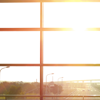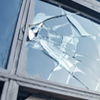Greenhouse gases (a combination of vapor, carbon dioxide, methane, nitrous oxide, and ozone) are in the earth’s atmosphere and act as a giant blanket that makes the earth warmer, referred to as the greenhouse effect. According to the Environmental Protection Agency (EPA), the carbon dioxide in the atmosphere has increased by nearly 40% since pre-industrial times – the current level is higher than it’s been in the last 800,000 years.
Window film is applied to glass to provide solar protection and increase energy efficiency by helping to reject heat in the summer and retain heat in the winter. This helps to reduce greenhouse gases in the following ways:
- Less electricity and natural gas are used for heating and cooling
- Fewer fossil fuels are burned
- Less carbon dioxide and other greenhouse gases are released into the atmosphere
Vicious Cycle
 Studies show that electricity (which is used for heating and cooling homes and businesses) is the biggest culprit for producing greenhouse gas emissions, which causes global warming, which causes climate change. One obvious result of this cycle is warmer temperatures. According to the First Biennial Report of the United States of America, 2012 was the hottest year ever in the United States, and the 12 hottest years globally all happened in the last 15 years. Not surprisingly, greenhouse gas emissions from electricity use by homes and businesses went up 28% in the last 15 years.
Studies show that electricity (which is used for heating and cooling homes and businesses) is the biggest culprit for producing greenhouse gas emissions, which causes global warming, which causes climate change. One obvious result of this cycle is warmer temperatures. According to the First Biennial Report of the United States of America, 2012 was the hottest year ever in the United States, and the 12 hottest years globally all happened in the last 15 years. Not surprisingly, greenhouse gas emissions from electricity use by homes and businesses went up 28% in the last 15 years.
Window Film to the Rescue
Now for some more encouraging facts from the International Window Film Association:
- Buildings account for 40% of all U.S. energy used
- Windows are responsible for 25% of a building’s consumed energy
- 40% of commercial buildings and 33% of residential buildings have single pane glass
So there is vast potential for window film to lower greenhouse gas emissions. Here’s a look at just one example: the Safeco Plaza in Seattle, Washington, was ahead of its time and installed window film in 1996. Not only did they reduce their carbon emissions each year, they also enjoyed annual savings of $200,000 – not to mention the government incentives and rebates they received. And with the way the U.S. government has been strengthening its charge to stop global warming as of late, those incentives will no doubt only get better.


 Staying within your budget is no exception when it comes to purchasing new windows. Installing new windows is not a small investment when the
Staying within your budget is no exception when it comes to purchasing new windows. Installing new windows is not a small investment when the  Windows have become more energy efficient over time and as a result have contributed to declining utility costs. Newer windows can better manage passive solar energy, leading to lower heating, cooling, and lighting costs. However, to achieve the maximum benefits, a more expensive window will be needed along with any additional features like blinds or curtains.
Windows have become more energy efficient over time and as a result have contributed to declining utility costs. Newer windows can better manage passive solar energy, leading to lower heating, cooling, and lighting costs. However, to achieve the maximum benefits, a more expensive window will be needed along with any additional features like blinds or curtains. If your home’s windows are broken, have rotted frames, or have reached the end of their useful life, then yes, it is time for new windows. If the main reason behind new window installation is to give your home a new look, you should consider window film.
If your home’s windows are broken, have rotted frames, or have reached the end of their useful life, then yes, it is time for new windows. If the main reason behind new window installation is to give your home a new look, you should consider window film.